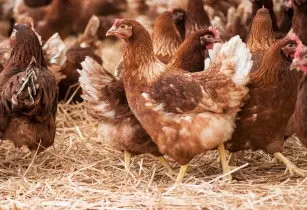The Food and Agriculture Organization of the United Nations (FAO), through its Emergency Centre for Transboundary Animal Diseases (ECTAD), has provided an effective model for coordination and technical support for high-impact emerging disease control, jointly with the Ministry of Animal Resources and Fisheries (MIRAH)
FAO has been at the forefront of the efforts to fight highly pathogenic avian influenza (HPAI) H5N1 in Côte d’Ivoire – which was confirmed in the West African nation in 2005 and again in 2015. The outbreak resulted in an estimated overall mortality rate of 56.7%.
FAO ECTAD, established in 2017 in Côte d’Ivoire, swiftly responded to increasing poultry mortality – as well as the risk of human infections resulting from HPAI – with a comprehensive and dynamic HPAI control programme in West and Central Africa.
As a result of increased active surveillance and vigilance in high-risk zones, information on suspected outbreaks including mortalities among poultry was reported in the southeastern region of Grand-Bassam. FAO ECTAD in Côte d’Ivoire is actively supporting national counterparts in the Directorates of Veterinary Services and Laboratories. In 2021, to support Côte d’Ivoire’s response against prioritised zoonotic diseases including HPAI, FAO ECTAD reinforced the capacities of 24 staff in the areas of animal sample collection, packaging and shipment and 48 staff from 21 structures of the National One Health Platform in Good Emergency Management Practices and leadership. Moreover 24 field staff are being mentored under the In-Service Applied Veterinary Epidemiology Training (ISAVET) programme.
FAO’s ongoing support to fight HPAI H5N1 in Côte d’Ivoire
FAO ECTAD has actively supported the Directorate of Veterinary Services (DSV) to respond to this emergency. Recent trainees of the FAO ISAVET programme will be supporting field activities. The support provided to the DSV includes the provision of relevant personal protective equipment (PPE) for the implementation of biosecurity/biosafety measures in farms and live birds markets, and surveillance at hotspots. The provided PPE is also being used during investigations as part of the updating of risk maps, which are needed to increase the understanding of the epidemiological links to the source of this infection.
This support has been expanded to other national structures. The National Agricultural Development Support Laboratory (LANADA) has been able to detect HPAI H5N1 and is preparing to ship samples and specimens for testing and genotyping at Istituto Zooprofilattico Sperimentale delle Venezie (Experimental Zooprophylactic Institute of Venice), the FAO Reference Centre for animal influenza and newcastle disease, located in Padua, Italy.
Regional and global efforts to address HPAI H5N1
The understanding that HPAI H5N1 is a pathogen that causes losses in poultry, but can occasionally spread to humans and cause epidemics and pandemics, has urged decision-makers to invest in response capabilities to address this health crisis. The complexity of the drivers of infectious diseases that have such a widespread impact has added impetus to incorporating One Health principles, which promote a multidisciplinary and multisectoral approach to addressing the outbreaks. HPAI H5N1 continues to be reported in several countries, and the risk of the emergence of new outbreaks remains.
Due to the emergence of other pandemics, such as COVID-19 and Ebola, the disease is under-reported and surveillance efforts are declining in most countries, particularly with a chronic shortage of financial and human resources. It is also clear that it would take several years for countries where the disease is endemic to eradicate the H5N1 virus from the poultry sector.








